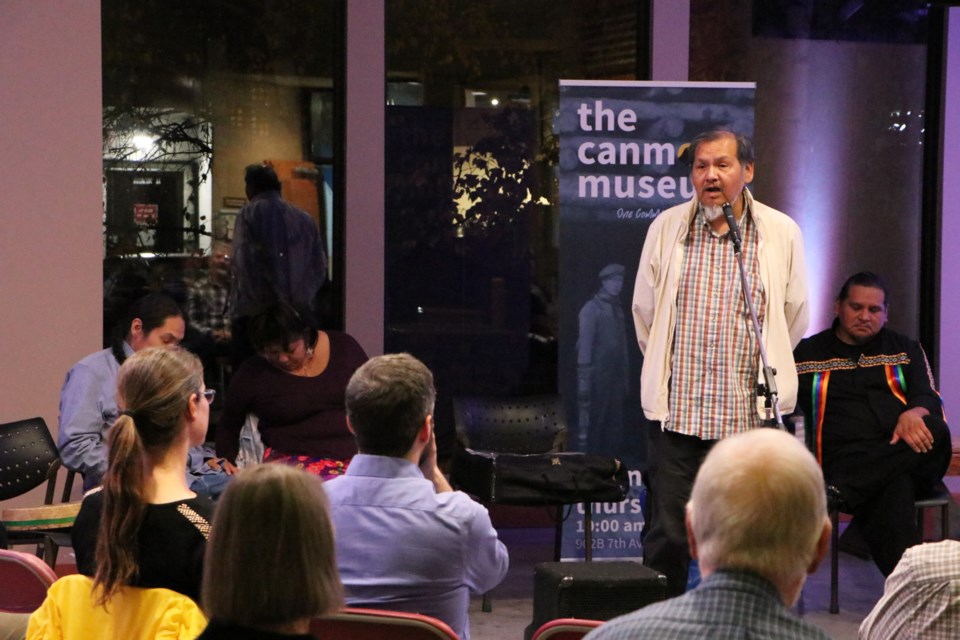CANMORE – Four Îyarhe (Stoney) Nakoda First Nation elders and knowledge keepers are helping to guide the Canmore Museum on a path to build bridges between Indigenous and non-Indigenous communities in the Bow Valley.
The Stoney Nakoda Advisory Circle, comprised of chair John Snow Jr. of Chiniki First Nation, David Bearspaw of Bearspaw First Nation, and Trudy Wesley and Glenda Crawler of Goodstoney First Nation, will help to guide the museum in exploring its role in addressing the difficult legacy of Canadian colonialism and settlement in relation to Indigenous peoples.
Joining them is Snow’s brother, Tony, who began a two-year residency at the museum as curator of Indigenous content Oct. 1 through a partnership between the Canmore Museum, the Alberta Museums Association and Athabasca University.
At the museum’s welcoming ceremony for the Îyarhe Nakoda members Thursday (Oct. 6), the Snow brothers – descendants of former Îyarhe Nakoda Goodstoney chief John Snow – spoke of being invited to share knowledge in their ancestral homelands, a place their forebears were removed from by the Canadian government.
“Tonight, we’re changing that narrative of removal to one of inclusion; a narrative of hope and a narrative of our shared history,” said Snow.
“This is part of truth and reconciliation – understanding one another, learning the language and gaining a new perspective.”
Under the guidance of the advisory circle and with Tony at the helm of Indigenous content, the museum will use its space to share the stories and cultural teachings of the Îyarhe Nakoda, as told by them.
Such stories will include a history of the relationship between the area’s Indigenous and non-Indigenous people.
“It is important that when we think about some of the history here more recently, that we think about the RCMP building and the prison at the North West Mounted Police [NWMP] barracks,” said Tony in his address to a room of about 25 people. “We remember that was built for us if we were to wander off our reserves and come into the towns.”
In addition to the removal of the Îyarhe Nakoda from their traditional territory in Banff National Park, the movement of First Nations people off reserves – newly established through the numbered treaties – was restricted by a pass system born out of the Indian Act in July 1885.
The pass system was introduced in the wake of the North-West Resistance and was enforced by the Department of Indian Affairs, which amended the Indian Act to give local Indian Agents the power of a Justice of the Peace.
First Nations people, mainly in Treaty 4, Treaty 6 and Treaty 7 areas, could be detained or imprisoned by the NWMP for leaving reserves without an approved permit signed by an Indian Agent. The federal government announced it was phasing out the pass system in 1941.
About 80 years later, Snow said inviting Îyarhe Nakoda members to be a part of how the history of the Bow Valley is told is an important part of reconciliation between the area’s Indigenous and non-Indigenous peoples.
“We have a rich heritage to share,” he said. “And we hope to shape a different history, a different future.”
On Sept. 27, days before the second annual National Day for Truth and Reconciliation, the Canadian Museums Association released a report detailing a national strategy to support Indigenous-led reconciliation in the museum sector.
Museums can support decolonization in 30 ways, the report states, including recognizing Indigenous peoples' intellectual sovereignty over all material created by or about them and taking Indigenous experience and knowledge into account when developing hiring policies.
Executive director and CEO of the Alberta Museums Association Jennifer Forsythe, who was invited to speak at the Canmore Museum’s welcoming ceremony, said the two-year residency with Tony is part of an emerging Indigenous museum professional pilot program being offered across the province.
There are six individuals currently registered.
“We are providing the learning, we are providing free access to our conference and advisory services, and the AMA staff will be meeting with these individuals to provide advisory support when they want it,” said Forsythe. “Participants are brought together in an online format over the course of the year, so they can also work with each other and share their stories.”
Snow said the reconciliation work being done in Canmore, through the museum and elsewhere, says a lot about the community’s commitment to making right relations with the area’s First Nations people.
“The Town of Canmore has done a lot of work,” he said. “Chuwapchîchiyan Kudi Bi (Canmore) is a proud name to hold now, as you’re earning your name; you’re earning your place in history.”
The Local Journalism Initiative is funded by the Government of Canada. The position covers Îyârhe (Stoney) Nakoda First Nation and Kananaskis Country.




